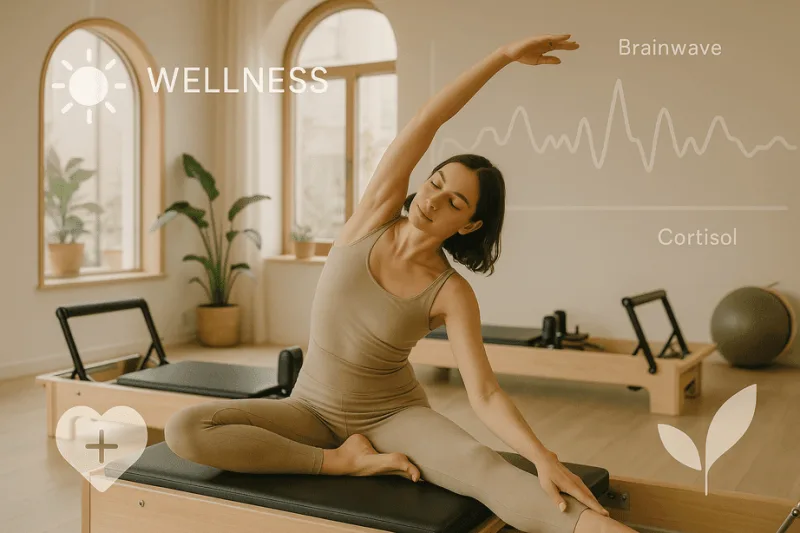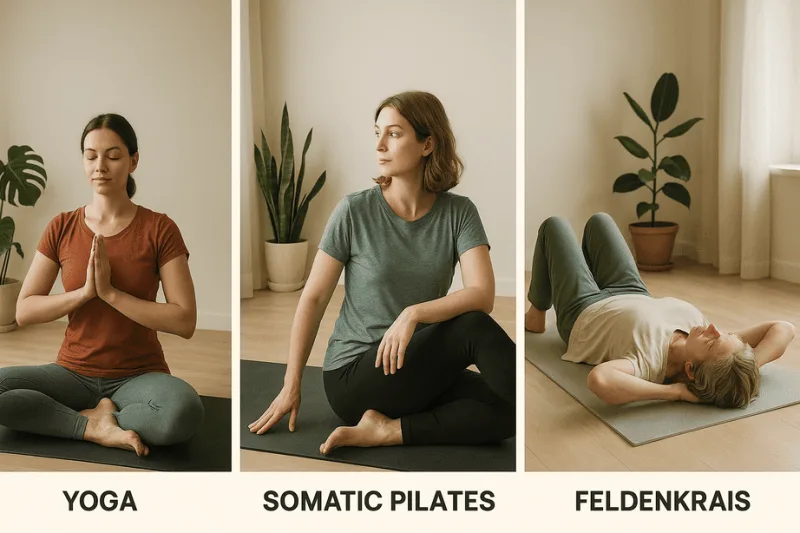Somatic Pilates is a gentle, science-based method for chronic pain relief, improved posture, and deeper mind-body awareness. It is perfect for beginners, seniors, and anyone seeking lasting wellness.
Introduction: Why Somatic Pilates Matters
Somatic Pilates is a revolutionary approach to reconnecting the mind and body in modern wellness and rehabilitation. Unlike traditional Pilates or yoga, somatic Pilates prioritizes internal awareness, conscious movement, and nervous system re-patterning. It’s not just a workout—it’s a method to retrain how your brain perceives and directs your body. Whether you’re recovering from injury, managing chronic pain, or simply seeking a mindful way to move, somatic Pilates offers proven benefits. In this complete guide, we’ll explore everything you need to know about somatic Pilates, from its core principles to real-world results.
What Exactly Is Somatic Pilates?
Somatic Pilates is a unique fusion of somatic education and the Pilates movement. The term “somatic” refers to the body’s internal experience—how it feels from the inside, not how it looks from the outside. Combined with Pilates, it becomes a form of neuromuscular re-education designed to release tension, improve posture, and reduce pain.
Combining mindfulness, controlled breathing, and slow, intentional movement, somatic Pilates helps the brain form healthier movement patterns and increases body awareness.
How Somatic Pilates Differs from Traditional Pilates
| Feature | Traditional Pilates | Somatic Pilates |
| Focus | Core strength & alignment | Nervous system & body awareness |
| Speed | Moderate to high-paced | Slow and mindful |
| Goal | Toning, posture, flexibility | Re-patterning movement & reducing tension |
| Suitable for | Fitness & toning | Rehabilitation, stress relief, chronic pain |
Somatic Pilates goes beyond the physical body. It addresses the brain-body connection, helping you become aware of unconscious muscular habits and offering tools to change them consciously.

Top Benefits of Somatic Pilates
1- Relief from Chronic Pain
Somatic Pilates helps retrain your nervous system to let go of long-held tension. This makes it especially effective for easing lower back pain, stiff necks, sore shoulders, and joint discomfort—without aggressive stretching or force.
2- Naturally Better Posture & Spine Health
Instead of forcing your body into rigid alignment, somatic Pilates encourages it to relearn its natural, balanced position. The result? Less strain, better posture, and a healthier spine.
3- Gentle Flexibility That Lasts
Forget painful stretches. This approach helps your muscles and fascia release at their own pace, building real, lasting flexibility that supports your daily movement.
4- Calmer Mind, Lower Stress
With a strong focus on breath and awareness, somatic Pilates activates your body’s relaxation response—helping to lower cortisol, ease anxiety, and bring a sense of calm to your mind and body.
5- Improved Mobility & Movement Awareness
By tuning into your body’s internal cues (proprioception), you’ll move with more control, confidence, and fluidity—whether exercising or just going about daily life.

Who Can Benefit from Somatic Pilates?
- Office workers suffering from posture-related discomfort
- Athletes aiming to prevent injuries and enhance performance
- Seniors needing a gentle, joint-friendly approach to movement
- Rehabilitation patients recovering from surgeries, strokes, or chronic pain
- Individuals with anxiety or tension disorders
Whether young or elderly, sedentary or active, somatic Pilates meets you at your current level.
Key Principles Behind Somatic Pilates
- Mindfulness in Movement: Every exercise is an opportunity to reconnect with your body’s inner signals.
- Neuro-muscular Repatterning: The focus isn’t on “doing” exercises but on retraining your body’s movement.
- Breath-Driven Flow: Breath guides movement’s timing, rhythm, and fluidity.
- Gentle Exploration: Movements are slow, small, and exploratory—never forced.
Sample Somatic Pilates Exercises for Beginners
Here are a few simple movements to start integrating somatic Pilates into your routine:
- Pelvic Clock: Lie on your back and gently rotate your pelvis as if tracing the face of a clock.
- Shoulder Rolls with Breath: Slowly roll one shoulder at a time in a circular motion, syncing with your inhale and exhale.
- Somatic Cat-Cow: Unlike the yoga version, this one emphasizes micro-movements and spinal articulation awareness.

Aim to practice 2–3 times a week, even if just for 15–20 minutes. Consistency is more important than duration.
Somatic Pilates vs Yoga and Feldenkrais
| Method | Somatic Pilates | Yoga | Feldenkrais |
| Mental focus | High | Moderate-High | High |
| Physical intensity | Low | Variable | Very Low |
| Neurological emphasis | Strong | Minimal | Strong |
| Emotional balance | Supported | Deep | Gentle |
| Breath integration | Core element | Key element | Optional |
While all three approaches enhance self-awareness and movement quality, somatic Pilates integrates Pilate’s structure with neurosensory feedback.

Scientific Evidence Supporting Somatic Pilates
Recent studies from institutions like Harvard and Stanford show that somatic movement practices can:
- Reduce chronic pain symptoms
- Improve sleep and reduce stress
- Enhance proprioception and motor control
- Support neurological recovery in stroke and injury patients
Experts in physical therapy and neurorehabilitation increasingly recommend somatic Pilates as part of holistic recovery plans.
FAQs About Somatic Pilates
Q1: Can beginners try somatic Pilates?
Yes! It’s designed for all levels—no flexibility or experience is required.
Q2: Is somatic Pilates the same as traditional Pilates?
No. It’s slower, more mindful, and focuses on nervous system retraining not just muscle tone.
Q3: How often should I practice?
Start with 2–3 sessions per week. Even short sessions are practical if done consistently.
Q4: Does it replace physical therapy?
No—but it complements it well, especially in pain management and movement retraining.
Q5: Can kids or seniors do somatic Pilates?
Yes. It’s gentle, safe, and adaptable for any age.
Q6: Do I need equipment?
Just a mat and a quiet space. Optional tools include small balls, cushions, or foam rollers.

Conclusion: Is Somatic Pilates Worth It?
Somatic Pilates is more than a physical exercise—it’s a science-based mind-body healing system. Addressing the root causes of pain, tension, and disconnection empowers you to move, feel, and live better.
Somatic Pilates is a practice worth exploring if you seek a gentle yet powerful way to reclaim your physical freedom and mental clarity.


